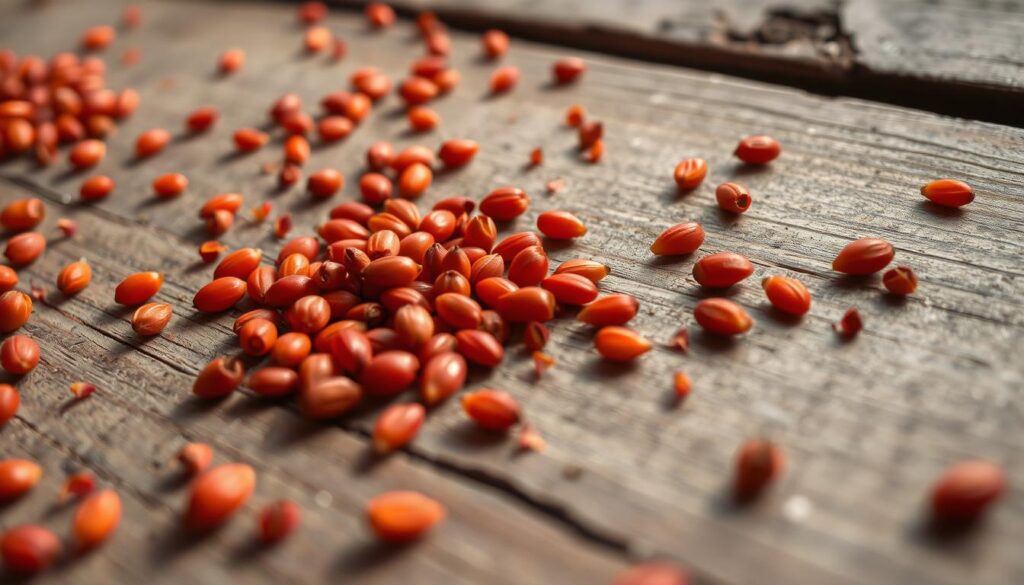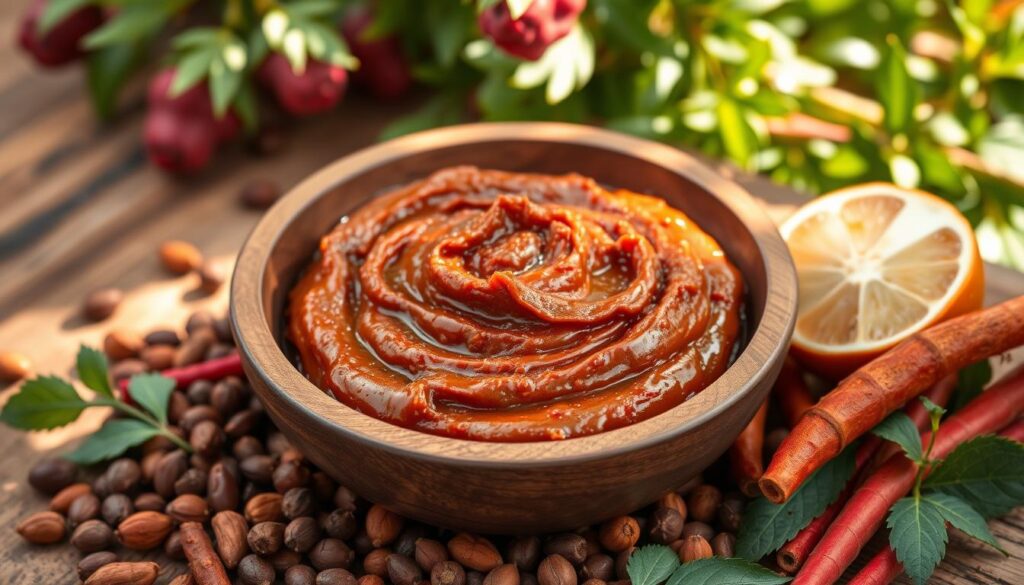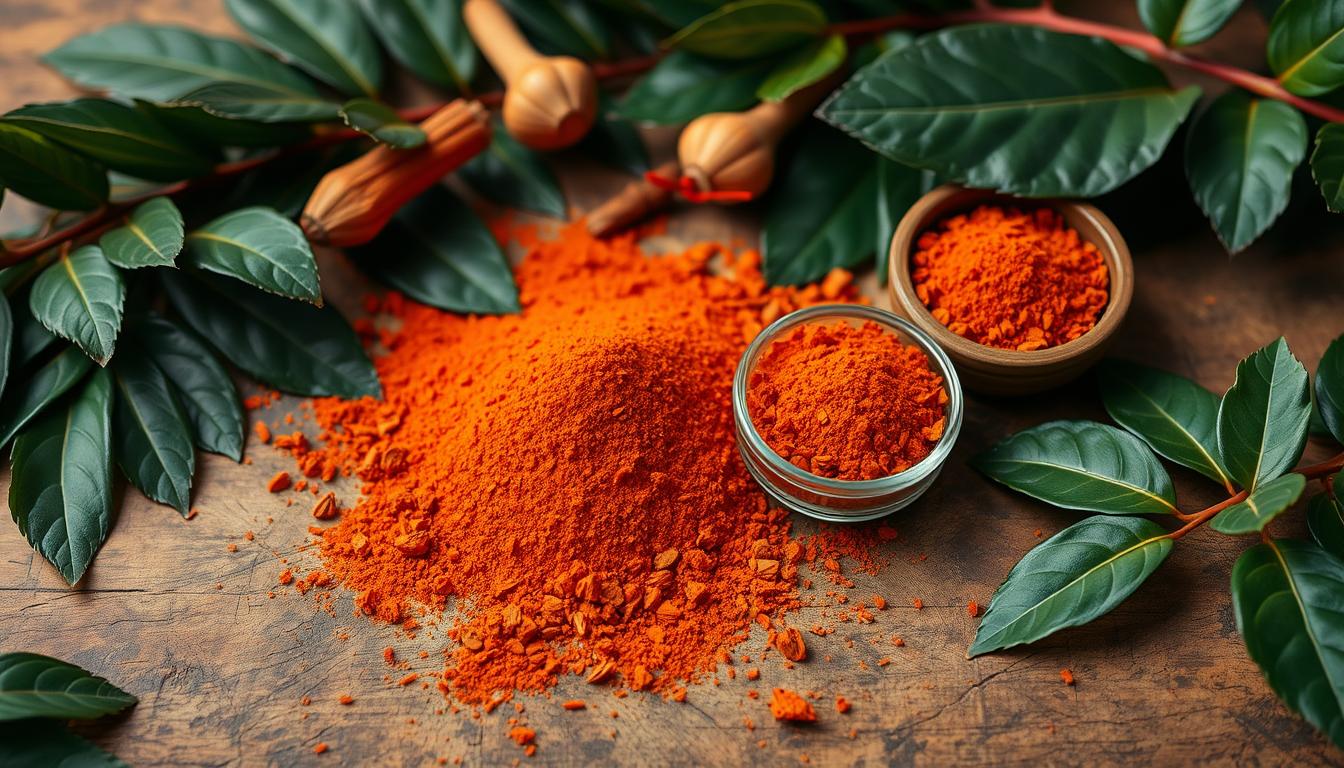When I enter my kitchen, the smell of achiote takes me to Mexico’s markets or the Caribbean’s streets. This spice, from the annatto tree, changes simple dishes into works of art. It delights with its peppery taste and earthy notes.
Achiote’s story is one of cultural mix, blending old traditions with new influences. Exploring this spice, you’ll find a world of history, flavor, and creativity. It’s a key part of many Latin American dishes.
Key Takeaways
- Achiote is a vibrant reddish-orange spice derived from the annatto tree, widely used in Latin American and Caribbean cuisines.
- Achiote serves as both a flavor enhancer and natural food coloring, contributing to the visual appeal and taste of traditional dishes.
- The spice is known for its slightly peppery flavor and earthy undertones, making it an essential ingredient in various regional recipes.
- Achiote reflects the blending of indigenous and colonial influences in Latin American cooking, symbolizing the fusion of traditions.
- The use of natural colorants like achiote in cooking offers nutritional benefits due to its antioxidant properties from carotenoids.
Understanding Achiote: Origins and Cultural Heritage
Achiote is a vibrant spice from Latin American cuisine. It comes from the Bixa orellana tree, found in South and Central America. This tree, called the “lipstick tree,” has been a key ingredient for indigenous communities for generations.
The Bixa Orellana Tree: Home of Achiote
The Bixa orellana tree, or annatto tree, is where achiote comes from. It’s a hardy, evergreen shrub that grows well in tropical climates. Its red-orange seeds give achiote its unique flavor and color.
Historical Significance in Indigenous Cultures
For centuries, indigenous cultures in Latin America have valued the Bixa orellana tree and its seeds. These seeds are used for cooking, but also for dyeing textiles, body paint, and cosmetics. This has made the tree known as “the lipstick tree,” showing its importance in the region’s traditions.
Traditional Uses Beyond Cooking
Achiote is not just for cooking. It has been utilized for centuries in conventional medicine. The seeds are known for their healing properties, such as reducing inflammation and fighting infections. This makes them a valuable part of traditional healing.

“The Bixa orellana tree has been an integral part of the cultural fabric of Latin America for centuries, serving as a source of nourishment, adornment, and traditional medicine for indigenous communities.”
Achiote’s importance shows how indigenous traditions and colonial influences have merged in Latin American cuisine. This has created a rich mix of flavors and practices that fascinate people worldwide.
The Distinctive Properties of Annatto Seeds
Annatto seeds are the vibrant heart of the achiote spice, known for their bright yellow-orange color. They are packed with carotenoids, mainly bixin and norbixin. These pigments give the spice its unique color and flavor. They also offer potential antioxidant benefits.
Annatto seeds can be used in many ways. They can be used whole, ground into a powder, or processed to extract the pigments. This makes them versatile for cooking, adding a golden glow to dishes. The color and flavor can be adjusted for different recipes.
| Annatto Seed Properties | Key Statistics |
|---|---|
| Global usage as a natural food coloring agent | Up to 70% of all natural food coloring agents |
| Common food and personal care applications | Baked goods, butter, cheese, ice cream, juices, makeup, shampoos, skincare |
| Carotenoid content | Primarily bixin and norbixin |
| Potential health benefits | Antioxidant properties, but further research needed |
Annatto is generally safe to eat, but some people might have bad reactions. This includes those with irritable bowel syndrome (IBS). Always talk to a healthcare professional before adding annatto to your diet or personal care routine.

“Annatto is a versatile natural pigment that has been used for centuries in various culinary and personal care applications. Its vibrant color and distinct flavor make it a unique and valuable ingredient.”
Achiote in Latin American Cuisine
Achiote, also known as annatto, is a key spice in Latin American dishes. It adds vibrant color and unique flavor. You can find it in whole seeds, ground powder, and as a paste mixed with spices.
Regional Cooking Applications
In Latin America, achiote is used in many ways. In Mexico, it’s a main ingredient in meat marinades. In the Yucatan, it’s used for cochinita pibil, a slow-roasted pork.
In Colombia, achiote colors and flavors arroz con coco, a coconut rice dish. Across the region, achiote sauces and stews add to traditional recipes.
Popular Dishes Featuring Achiote
- Cochinita Pibil (Mexico)
- Arroz con Coco (Colombia)
- Empanadas (Various countries)
- Arepas (Venezuela and Colombia)
- Moros y Cristianos (Cuba)
Traditional Preparation Methods
To prepare achiote, seeds are ground into a fine powder or infused in oil. These methods bring out its color and flavor. The achiote is then used in many dishes across the region.
| Dish | Primary Achiote Application | Region |
|---|---|---|
| Cochinita Pibil | Achiote paste in the marinade | Mexico |
| Arroz con Coco | Achiote oil infusion | Colombia |
| Empanadas | Achiote powder in the dough | Various Latin American countries |

“Achiote is an essential ingredient that brings the vibrant flavors and colors of Latin American cuisine to life. Its versatility allows it to be used in a wide range of dishes, from savory stews to bright, aromatic rice dishes.”
Health Benefits and Nutritional Value
Achiote, also known as annatto, is more than a vibrant spice. It’s a treasure trove of health benefits. This plant is full of antioxidants and carotenoids that can improve your well-being.
Achiote’s seeds are deep red and have been used for healing. The Tsáchila people of Ecuador have used them for their antioxidant, anti-inflammatory, and antimicrobial properties. This makes achiote a great ally against many ailments.
- Achiote can be used both inside and outside the body. It’s good for treating wounds, digestive issues, and even as a natural insect repellent.
- The antioxidant compounds in achiote may protect cells from damage. This could lower the risk of diseases like cancer, heart disease, and Alzheimer’s.
- Achiote’s anti-inflammatory properties can reduce body inflammation. This is linked to many chronic conditions.
- Also, achiote’s antimicrobial effects can fight off harmful bacteria and fungi. This could help prevent infections.
More research is needed to fully understand achiote’s health benefits. But, its traditional use and some scientific studies suggest it could be good for your health. Always talk to a healthcare professional before adding any new supplement or remedy, especially if you have health conditions or take medication.
Achiote’s journey from ancient rituals to modern kitchens has made it popular worldwide. Its versatility and potential health benefits make it an interesting spice to try in your cooking and wellness routines.
Culinary Applications and Cooking Techniques
Achiote, a vibrant spice from Latin America, is very versatile. It can be used to make flavorful pastes, enhance marinades, and add color and taste to dishes.
Creating Achiote Paste
To make a traditional achiote paste, annatto seeds are ground with spices, herbs, and liquids. This paste is great for marinating meats, adding bold flavor and a reddish-orange color.
Marinades and Seasonings
Achiote is key in Latin American marinades. It’s used in Achiote Chicken, or Pollo Pibil. The marinade, with citrus, spices, and garlic, gives meat a unique taste.
Color and Flavor Enhancement
Achiote is not just for marinades. It can also be used in rice, soups, and stews. A little achiote powder or paste adds color and a subtle flavor. Cooking techniques vary, focusing on color or flavor.
| Achiote Powder Recommendation | Achiote Marinade Ingredients | Achiote Chicken Recipe Details |
|---|---|---|
| Achiote powder is recommended for the lemon achiote grilled tofu recipe. |
|
|
Whether you’re making a vibrant achiote paste, creating marinades, or adding color and taste to dishes, achiote offers endless possibilities in the kitchen.
Natural Food Coloring Properties
The vibrant Achiote spice is more than just a flavorful addition to Latin American cuisine. It is a key natural food dye source globally. The food industry uses it to create a wide range of colors, from deep yellows to vibrant orange-reds. This is done by adjusting the levels of bixin and norbixin in achiote extracts.
Other than achiote, the food industry uses many plant-based pigments. These are used in products like cheese, butter, margarine, ice cream, and baked goods. Carotenoids, chlorophyllin, anthocyanins, and betanin are some of the main natural food coloring agents used today. These natural colors, like annatto (E160b), caramel coloring (E150a-d), carmine (E120), and turmeric, are better than synthetic dyes.
More people want natural food colorings because they are better for the planet. Natural food dyes often have health benefits, like antioxidants. They are also safer for our food.
“The future of food coloring seems to favor natural alternatives as innovations in extraction and preservation methods make natural colorings more appealing.”
The demand for natural food coloring agents, like achiote extracts, is growing. This will lead to more progress in making these sustainable and healthy ingredients.
Purchasing and Storage Guidelines
When picking achiote powder or achiote seeds, look for bright, even colors. The achiote seeds should be hard and dry. Storing achiote right is key for the best quality and flavor.
Choosing Quality Achiote Products
You can find achiote in specialty stores, Latin American markets, or online. When buying, check the achiote powder or seeds for these signs:
- Vibrant, consistent color
- Hard, dry achiote seeds free from moisture
- Freshness and lack of any off-putting odors
Proper Storage Methods
To keep your achiote’s color and flavor good, follow these storage tips:
- Store achiote in airtight containers away from direct light and heat.
- Whole achiote seeds last longer than ground achiote powder.
- Refrigerate achiote paste for up to 6-12 months in an airtight container.
- Keep achiote powder at room temperature for 1-2 years in a sealed package.
By following these tips, you’ll always have top-notch achiote for your Latin American dishes.
Modern Commercial Uses and Applications
The achiote plant has found new uses beyond cooking. It’s now used in the cosmetics industry and commercial food production. This natural colorant is making waves in many fields.
In cosmetics, achiote extracts are loved for their bright colors and natural benefits. Lipsticks and eye shadows use achiote for a green, natural colorants option instead of synthetic dyes.
The food industry also values achiote. It’s used to color many processed foods. This move towards natural colors meets the growing need for clean, simple food products.
Achiote’s uses go beyond food and cosmetics. It’s also used in textiles and some industrial products. This shows how adaptable and versatile the plant is.
As people look for sustainable, plant-based options, achiote’s role is growing. It’s becoming a key player in commercial food production, cosmetics industry, and natural colorants.
“Achiote has emerged as a versatile natural solution, catering to the increasing consumer appetite for environmentally conscious and ethically sourced products.”
Conclusion
Achiote is a vibrant spice from the annatto plant, key in Latin American cooking. It has a unique taste, from sweet to earthy, and a bright orange-red color. This makes achiote valuable in both old and new recipes.
As people look for natural ingredients, achiote’s health benefits and coloring power will grow. It’s becoming more important in cooking and other fields.
Achiote’s history is tied to indigenous communities, showing its deep cultural value. It’s used in marinades, seasonings, and even as a natural dye. This spice is a big part of Latin American identity.
As demand for real ingredients grows, achiote’s role will expand. It will keep being a cherished part of Latin American culture.
Exploring achiote in Latin American dishes or modern recipes is exciting. It takes you on a journey through the region’s traditions and natural wonders. By using achiote, you celebrate its heritage and potential, making it a key part of the culinary world.

